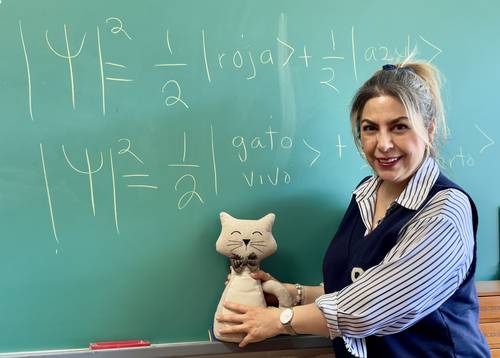Alejandra López Suárez, an expert in the interaction of radiation with subject and its applications, stressed that understanding quantum mechanics It is essential to work with semiconductors, since these materials depend on quantum principles for their operation and I am interested in modifying the properties of semiconductors to make them more efficient
.
The semiconductors, materials that have an intermediate electrical conductivity between drivers and insulators, are the basis of modern technology, from solar panels to computers.
In an interview, the scientist mentioned that a chemical doping is a process by which controlled impurities are introduced to modify the electrical properties of a semiconductor. Energy levels and electrons mobility in a semiconductor are governed by quantum principles. Understanding that, I can modify the material so that it absorbs more light and turns it into energy more efficiently
.
Another way to do semiconductors to modify their physical properties is ionic implementation. This technique is characterized by altering the structure of the material when impacting with positive ions. The great advantage of this technique is that there is great control of the semiconductor area that will be equipped, because the energy of the ionizing particles is directly related to the depth to which the implanted ions are deposited.
He added that another peculiarity of ionizing radiation, which includes X -rays, gamma rays, positive ions, beta particles and neutrons, They have enough energy to start electrons from the semiconductor atoms or produce defects in the crystalline structure when interacting with the nuclei of the atoms that form the material
.
Here, quantum mechanics is key because it determines how electrons, nuclei or material atoms respond to ionizing radiation. At present, López Suárez analyzes samples of tungsten trioxide, an electrocromic material, which change color when passing a current through them. These materials are used in intelligent windows or glass, and work in a similar way to the masks that appear in the police series, where when activating they can be seen through them and by deactivating them they become opaque.
We want to see if through ionizing radiation we can modify the structure of the material to optimize its operation. Here is also present quantum mechanics, because in these types of materials there are certain reactions that modify their energy bands by interacting with visible light.
For the scientist, modifying semiconductors with ionizing radiation and knowledge of quantum mechanics is similar to pastry. If we have a vanilla paste
.
López Suárez believes that in the future the great challenge is to use this knowledge to develop more efficient, small and sustainable semiconductors. But it also highlights the importance of bringing quantum mechanics to more people and strengthening the link between basic research and industry.
Understanding quantum mechanics allows us to design materials with better properties, and that has a direct impact on the technology we use every day.
In his cubicle of the Institute of Physics of the UNAM, Alejandra López has a small rag cat, which he took care of his desk and placed it inside a box. Right now, this cat can be alive and dead at the same time
he expressed with a smile, closing the lid.
The Schrödinger cat paradox, devised by Austrian physicist Erwin Schrödinger in 1935, is one of the most famous mental experiments of quantum physics. Illustrates the phenomenon of quantum overlap, a property that defies classical intuition: in the quantum world, a particle can exist in multiple states at the same time until it is observed.
In the International Year of Quantum Science and Technology, this principle continues to challenge our understanding of the Universe and raid out the way for advances such as quantum computing and ultra -registered cryptography. It is also fundamental in the development of more efficient technologies, such as semiconductors, a field in which López Suárez has specialized.
Throughout her professional experience, the researcher has worked in different areas of physics. During his doctorate he studied how hydrogen is absorbed in metals to create metal hydros, which will be the basis of fuel batteries from hydrogen; and how ionizing radiation can modify these materials to make them more efficient.
